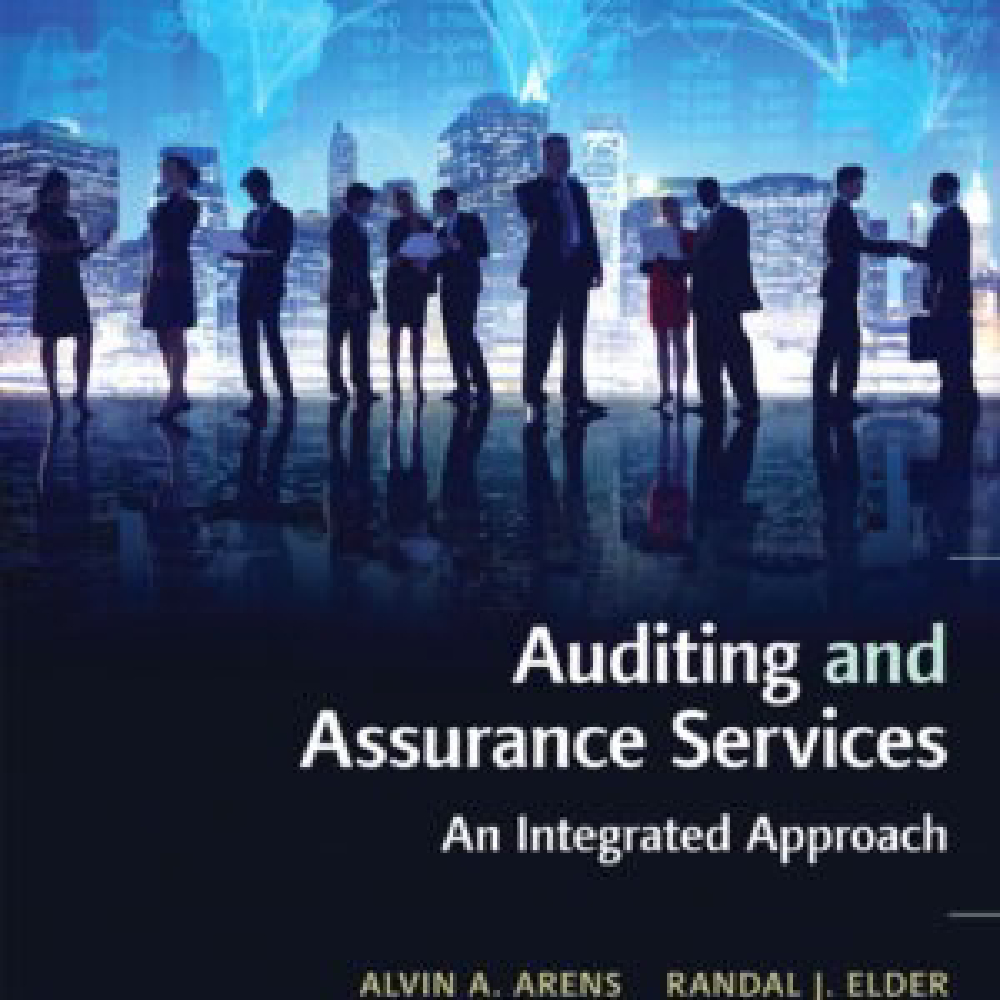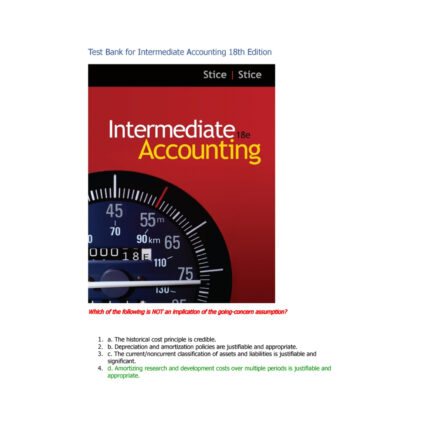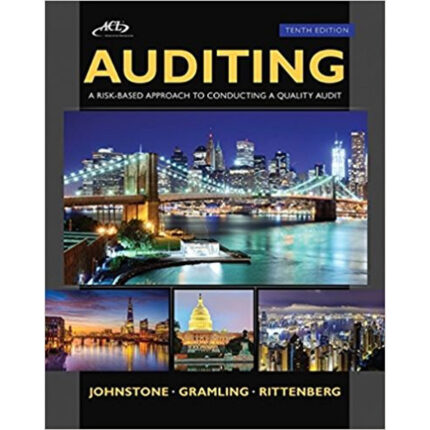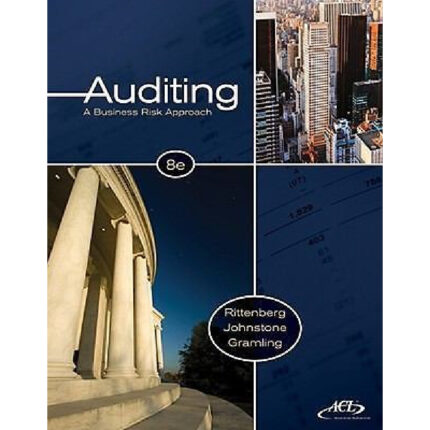Auditing And Assurance Services An Integrated Approach 16th Edition By Arens – Test Bank
Chapter 11 Internal Control and COSO Framework
11.1 Learning Objective 11-1
1) Which of the following is not one of the three primary objectives of effective internal control?
A) reliability of financial reporting
B) efficiency and effectiveness of operations
C) compliance with laws and regulations
D) assurance of elimination of business risk
Answer: D
Terms: Internal control objectives
Diff: Easy
Objective: LO 11-1
AACSB: Analytic thinking
2) With which of management’s assertions with respect to implementing internal controls is the auditor primarily concerned?
A) efficiency of operations
B) reliability of financial reporting
C) effectiveness of operations
D) compliance with applicable laws and regulations
Answer: B
Terms: Management’s assertions and internal control
Diff: Easy
Objective: LO 11-1
AACSB: Reflective thinking
3) Internal controls
A) are implemented by and are the responsibility of the auditors.
B) consist of policies and procedures designed to provide reasonable assurance that the company achieves its objectives and goals.
C) guarantee that the company complies with all laws and regulations.
D) only apply to SEC companies.
Answer: B
Terms: Internal controls
Diff: Moderate
Objective: LO 11-1
AACSB: Analytic thinking
4) Internal controls are not designed to provide reasonable assurance that
A) all frauds will be detected.
B) transactions are executed in accordance with management’s authorization.
C) the company’s resources are used efficiently and effectively.
D) company personnel comply with applicable rules and regulations.
Answer: A
Terms: Internal controls; Reasonable assurance
Diff: Moderate
Objective: LO 11-1
AACSB: Analytic thinking
5) Describe each of the three broad objectives management typically has for internal control. With which of these objectives is the auditor primarily concerned?
Answer: The three objectives are:
• Reliability of financial reporting. Management has both a legal and professional responsibility to be sure that the information is fairly presented in accordance with reporting requirements such as U.S. GAAP and IFRS.
• Efficiency and effectiveness of operations. Controls within an organization are meant to encourage efficient and effective use of its resources to optimize the company’s goals.
• Compliance with laws and regulations. Public, non-public, and not-for-profit organizations are required to follow many laws and regulations. Some relate to accounting only indirectly, such as environmental protection and civil rights laws. Others are closely related to accounting, such as income tax regulations and anti-fraud legal provisions.
The auditor’s focus in both the audit of financial statements and the audit of internal controls is on the controls over the reliability of financial reporting plus those controls over operations and compliance with laws and regulations that could materially affect financial reporting.
Terms: Three broad objectives management has for internal control
Diff: Easy
Objective: LO 11-1
AACSB: Reflective thinking
6) Section 404 of the Sarbanes-Oxley Act requires that both private and public companies issue an internal control report.
Answer: FALSE
Terms: Sarbanes-Oxley Act
Diff: Easy
Objective: LO 11-1
AACSB: Reflective thinking
Topic: SOX
7) Management has a legal and professional responsibility to be sure that the financial statements are prepared in accordance with reporting requirements of applicable accounting frameworks.
Answer: TRUE
Terms: Internal controls
Diff: Moderate
Objective: LO 11-1
AACSB: Reflective thinking
11.2 Learning Objective 11-2
1) Who is responsible for establishing a private company’s internal control?
A) senior management
B) internal auditors
C) FASB
D) audit committee
Answer: A
Terms: Internal controls
Diff: Easy
Objective: LO 11-2
AACSB: Reflective thinking
2) Two key concepts that underlie management’s design and implementation of internal control are
A) costs and materiality.
B) absolute assurance and costs.
C) inherent limitations and reasonable assurance.
D) collusion and materiality.
Answer: C
Terms: Internal control design and implementation
Diff: Easy
Objective: LO 11-2
AACSB: Analytic thinking
3) The PCAOB places responsibility for the reliability of internal controls over the financial reporting process on
A) the company’s board of directors.
B) the audit committee of the board of directors.
C) management.
D) the CFO and the independent auditors.
Answer: C
Terms: PCAOB; internal control responsibility
Diff: Easy
Objective: LO 11-2
AACSB: Reflective thinking
Topic: Public
4) Which of the following parties provides an assessment of the effectiveness of internal control over financial reporting for public companies?
A)
Management Financial statement auditors
Yes Yes
B)
Management Financial statement auditors
No No
C)
Management Financial statement auditors
Yes No
D)
Management Financial statement auditors
No Yes
Answer: A
Terms: Internal control effectiveness
Diff: Easy
Objective: LO 11-2
AACSB: Reflective thinking
5) An act of two or more employees to steal assets and cover their theft by misstating the accounting records would be referred to as
A) collusion.
B) a material weakness.
C) a control deficiency.
D) a significant deficiency.
Answer: A
Terms: Collusion
Diff: Easy
Objective: LO 11-2
AACSB: Reflective thinking
6) Sarbanes-Oxley requires management to issue an internal control report that includes two specific items. Which of the following is one of these two requirements?
A) a statement that management is responsible for establishing and maintaining an adequate internal control structure and procedures for financial reporting
B) a statement that management and the board of directors are jointly responsible for establishing and maintaining an adequate internal control structure and procedures for financial reporting
C) a statement that management, the board of directors, and the external auditors are jointly responsible for establishing and maintaining an adequate internal control structure and procedures for financial reporting
D) a statement that the external auditors are solely responsible for establishing and maintaining an adequate system of internal control
Answer: A
Terms: Sarbanes-Oxley; Internal control report
Diff: Easy
Objective: LO 11-2
AACSB: Reflective thinking
Topic: SOX
7) When management is evaluating the design of internal control, management evaluates whether the control can do which of the following?
A)
Detect material misstatements Correct material misstatements
Yes Yes
B)
Detect material misstatements Correct material misstatements
No No
C)
Detect material misstatements Correct material misstatements
Yes No
D)
Detect material misstatements Correct material misstatements
No Yes
Answer: C
Terms: Internal control design
Diff: Easy
Objective: LO 11-2
AACSB: Reflective thinking
8) When one material weakness is present at the end of the year, management of a public company must conclude that internal control over financial reporting is
A) insufficient.
B) inadequate.
C) ineffective.
D) inefficient.
Answer: C
Terms: Internal control weakness; Public company
Diff: Easy
Objective: LO 11-2
AACSB: Analytic thinking
Topic: Public
9) The auditors primary purpose in auditing the client’s system of internal control over financial reporting is
A) to prevent fraudulent financial statements from being issued to the public.
B) to evaluate the effectiveness of the company’s internal controls over all relevant assertions in the financial statements.
C) to report to management that the internal controls are effective in preventing misstatements from appearing on the financial statements.
D) to efficiently conduct the Audit of Financial Statements.
Answer: B
Terms: Primary purpose to audit system of internal control
Diff: Moderate
Objective: LO 11-2
AACSB: Reflective thinking
Topic: Public
10) The internal control framework used by most U.S. companies is the ________ framework.
A) FASB
B) PCAOB
C) COSO
D) SEC
Answer: C
Terms: Internal control framework; COSO
Diff: Moderate
Objective: LO 11-2
AACSB: Reflective thinking













Reviews
There are no reviews yet.